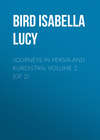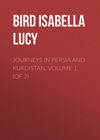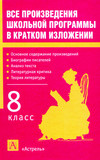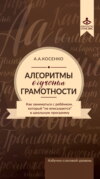Читать книгу: «Journeys in Persia and Kurdistan, Volume 2 (of 2)», страница 2
This morning, soon after leaving Mowaz, the Sahib's guide galloped up, saying that his master had been robbed of "everything" the night before, and was without the means of boiling water. Orders were given for the camps to close up, for no servants to ride in advance of or behind the caravan, and that no Ilyats should hang about the tents.
Although the Bakhtiari Lurs are unified under one chief, who is responsible to the Shah for the security of the country, and though there has been a great improvement since Sir A. H. Layard's time, the advance, I think, is chiefly external. The instincts and traditions of the tribes remain predatory. Possibly they may no longer attack large caravans, but undoubtedly they rob, when and where they can, and they have a horrid habit of stripping their victims, leaving them with but one under garment, if they do not kill them. They have a gesture, often used by Aziz Khan in his descriptions of raids, which means stripping a man to his shirt. The word used is skin, but they are not such savages as this implies. The gesture consists in putting a finger into the mouth, slowly withdrawing it, and holding it up with a look of infinite complacency. Aziz admits with some pride that with twenty men he fell upon a rich caravan near Shiraz, and robbed it of £600.
To-day's march has been mainly through very attractive scenery. We crossed the Ab-i-Mowaz, proceeded over slopes covered with wheat and flowers, and along a rocky path overhanging the exquisitely tinted Bazuft, forded the Ab-i-Nozi, at a place abounding in tamarisks bearing delicate, feathery pink blossoms, and ascended to upland lawns of great beauty, on which the oaks come down both in clumps and singly, as if planted. The views from this natural park are glorious. Besides the great ranges with which I have become familiar, the Safid-Kuh, or "white mount," on the right bank of the river, at present deserves its name, its snows descending nearly to the forests which clothe its lower heights. A deep chasm conceals the Tabarak stream up to the point of its foamy junction with the Bazuft, which emerges on the valley by an abrupt turn through a very fine cañon.
We crossed the pure green waters by a broad ford, and camped on the right bank on a gravel plateau above it, on which is Killa Bazuft, a large quadrangular stone fort with round towers at the corners, an arcaded front, a vaulted entrance, and rooms all round the quadrangle. It is now ruinous. Some irrigated land near it produces rice and mosquitos. The Sahib's camp is pitched here. He has been badly robbed, both of clothing and cooking-pots, and was left without the means of cooking any food.
Dima, June 26.– We retraced our steps as far as the source of the Duab, crossed into the Shamisiri valley, and by a low pass into the Karun valley, forded the Karun by a strong deep ford, crossed a low range into the Zarin valley, where are some of the sources of the Zainderud, from thence marched to the Tang-i-Ghezi, through which the Zainderud, there a vigorous river, passes into the Chahar Mahals, went up the Kherson valley, crossed Gargunak, and by a very steep and rugged descent reached this camp, a place of springs, forming the upper waters of the Zainderud. These days have been severe, the heat great, and the incidents few.
The ascent of the Gardan-i-Cherri was difficult. The guide misled us, and took us through a narrow rift in the crest of a ridge on broken ledges of rock. We camped at a height of 9000 feet in the vicinity of snow. The new arrangement, which is necessary for safety, does not increase comfort, for the Arab horses, noisy, quarrelsome fellows, are in camp, and the mules shake their bells and sneeze and bray at intervals all night.
The descent of 2000 feet into the Shamisiri valley, over bare gravel chiefly, was a very hot one. It is a wide, open valley with stony hills of no great height enclosing it, with much green sward along the river banks, above which, running to a great height on the hillsides, are stretches of irrigated wheat. So far as I have yet seen, the wheat is all "bearded." It is a most smiling valley; so cultivated, indeed, and so trim and free from weeds are the crops, that one naturally looks for neat farm-houses and barns. But one looks in vain, for except the ruins of some Armenian villages there are no traces of inhabitants, till night comes, when the glimmer of camp fires here and there high up on the hillsides shows the whereabouts of some migratory families.
I start so early as to get in to the camping-ground about nine now, and the caravan, two hours later, comes in with mules braying, bells ringing, horses squealing for a fight, servants shouting. Then the mules roll, the tent-pegs are hammered down, and in the blazing, furnace-like afternoons the men, who have been up since 2 a. m., take a prolonged siesta, and a solemn hush falls on the camp. After the Gorab affair I loaded my revolver, and now sleep with it under my pillow, carry it in my holster, and never have it out of my reach. I think I should only fire it in the air if I were attacked, but the fact of being known to be armed with such a weapon is more likely than anything else to prevent attack. No halt is now made on the march.
The sick people who appeared at Shamisiri, from no one knows where, were difficult and suspicious, and so they have been since. The dialect of Persian has somewhat changed, and Aziz Khan now interprets the strange accounts of maladies to Mirza, and he interprets to me. When they crowd almost into the tent, Aziz, when appealed to, pelts them with stones and beats them with a stick, and they take it very merrily. He thinks that I have appliances in the "leather box" for the cure of all ills, and when he brings blind people, and I say that I cannot do anything for them, he loses his temper. No matter where we camp, dark, handsome men spring up as if by magic, and hang about the fires for the rest of the day. From among these the guides are usually selected.
Numbers of "patients" appear everywhere, and the well assemble with the sick round my tent. At Berigun the people were very ignorant and obstinate. After spending a whole hour on two men, and making medicines up for them, they said they would have the "Feringhi's ointment," but "nothing that goes down the throat." Another said (and he had several disciples) that he would not take the medicine "for fear it should make him a Christian." One man, who has fever, took away four quinine powders yesterday for four days, and came back to-day deaf and giddy, saying that I have killed him. He had taken them all at once!
It is very pleasant to see how very fond the men are of their children, and how tender and loving they are to their little girls. The small children are almost always pretty, but by three years old the grace and innocence of childhood are completely lost, and as in Persia there are no child faces; indeed, the charm of childhood scarcely survives the weaning-day. If they are sick the fathers carry them for miles on their backs for medicine, and handle them very gently, and take infinite pains to understand about the medicine and diet. Even if both father and mother come with a child, the man always carries it, holds it, is the spokesman, and takes the directions. Several men have offered me mares and cows if I will cure their children. All the "patients" ask finally, "What must I eat, and not eat?"
The Bakhtiaris have often asked me whether it is unwholesome to live so much as they do on cheese and sour milk. They attribute much of their dyspepsia to their diet. They live principally on mast or curdled milk, buttermilk, cheese, roghan or clarified butter, nān, a thin leavened cake, made of wheat or acorn flour, bannocks of barley meal, celery pickled in sour milk, kabobs occasionally, and broth flavoured with celery stalks and garlic frequently. They never use fresh milk. They eat all fruits, whether wild or cultivated, while they are quite unripe. Almonds are eaten green.
They hunt the ibex and shoot the francolin and the bustard, and make soup of them. They are always on the hills after game, and spare nothing that they see. I have seen them several times firing at red-legged partridges sitting on their nests. They use eggs considerably, boiling them hard. Alcohol in any form is unknown among them, and few, except the Khans, have learned the delights of tea and coffee. Buttermilk, pure water, and sharbat, when they can get lime-juice, are their innocent beverages. The few who drink tea use it chiefly to colour and flavour syrup. They eat twice in the day. Though their out-of-doors life is healthy and their diet simple, they rarely attain old age. A man of sixty is accounted very old indeed. The men are certainly not polite to their wives, and if they get in their way or mine they kick them aside, just as rough men kick dogs.
We have been marching through comparatively lowland scenery, like the Chahar Mahals, from which we are not far. At Shamisiri, except for the fine peak of Dilleh, there are no heights to arrest the eye. The hills on the north side are low, gravelly, and stony, with perpendicular outbreaks of rock near their summits. To the south they are of a different formation, with stratification much contorted. The next march was over low stony hills, with scanty herbage and much gum tragacanth, camel thorn, and the Prosopis stephaniana, down a steep descent into the Karun valley, where low green foot-hills, cultivated levels, and cultivation carried to a great altitude on the hillsides refresh the tired eyes. The Karun, liberated for a space from its imprisonment in the mountains, divides into several streams, each one a forcible river, winds sinuously among the grass, gleams like a mirror, and by its joyous, rapid career gives animation to what even without it would be at this season a very smiling landscape. Crossing the first ford in advance of the guide, we got into very deep water, and Screw was carried off his feet, but scrambled bravely to a shingle bank, where we waited for a native, who took us by long and devious courses to the left bank. The current is strong and deep, and the crossing of the caravan was a very pretty sight.
We halted for Sunday at Berigun, an eminence on which are a ruinous fort, a graveyard with several lions rampant, and a grove of very fine white poplars, one of them eighteen feet in circumference six feet from the ground. A sea of wheat in ear, the Karun in a deep channel in the green plateau, some herbage-covered foot-hills, and opposite, in the south-west, the great rocky, precipitous mass of the Zard Kuh range, with its wild crests and great snow-fields, made up a pleasant landscape. The heat at this altitude of 8280 feet, and in the shade, was not excessive.
The next day's march was short and uninteresting, partly up the Karun valley, and partly over gravelly hills with very scanty herbage and no camps, from which we came down abruptly into the elevated plain of Cheshmeh Zarin (the Golden Fountain) at a height of 8500 feet, the plain being about five miles by two and a half. Receding hills with some herbage upon them border the plateau, and the Zard Kuh, though at some distance, apparently blocks up the western end. A powerful spring bursts from under a ridge of rock half-way down the plain, and becomes at once a clear gentle stream, fifty feet broad, which passes through the level green sward in a series of turns which are quite marvellous. Smooth sward, green barley, many yoke of big oxen ploughing up rich black soil, dark flocks of thousands of sheep and goats, asses, mares, mules, cows, all feeding, large villages of black tents, one of them surrounding the white pavilion of a Khan, saddle-horses tethered, flocks being led to and fro, others being watered, laden asses arriving and departing, butter being churned, and carpets being woven, form a scene of quiet but busy industry which makes one feel quite "in the world." This stream is one of the chief sources of the Zainderud.
From this cheerful camping-ground we marched over low hills, forded the Zainderud several times, and came upon several Ilyat camps on low, rich pasture lands. These nomads had no tents, but dwelt in booths without fronts, the roofs and backs being made of the tough yellow flowering stalks of the celery. The path follows the left bank of the river, there a full, broad stream, flowing through the Tang-i-Ghezi, through rounded hills, and scenery much like that of the Cheviots. At the Tang-i-Ghezi we camped, and this morning crossed a low hill into a heavily-grassed valley watered by the Kherson, ascended a shoulder of Gargunak, and halted at Aziz Khan's tents, where the women were very hospitable, bringing out cows' milk, and allowing themselves to be photographed.
An unpleasant contretemps occurred to me while we were marching through some very lonely hills. If Mirza rides as he should, behind me, his mule always falls out of sight, and he is useless, so lately I have put him in front. To-day I dropped a glove, and after calling and whistling to him vainly, got off and picked it up, for I am reduced to one pair, but attempt after attempt to get on again failed, for each time, as I put my hand on the saddle, Screw nimbly ran backwards, and in spite of my bad knee I had to lead him for an hour before I was missed, running a great risk of being robbed by passing Lurs. When Mirza did come back he left his mule in a ravine, exposed to robbers, and Aziz Khan was so infuriated that he threatened to "cut his throat." Aziz despises him as a "desk-bred" man for his want of "out-doorishness," and mimics the dreamy, helpless fashion in which he sits on his mule, but Mirza can never be provoked into any display of temper or discourtesy.
From Aziz's camp we had a very steep and rugged descent to this place, Cheshmeh Dima, where we have halted for two days. Three streams, the head-waters of the Zainderud, have their sources in this neighbourhood, and one of them, the Dima, rises as a powerful spring under a rock here, collects in a basin, and then flows away as a full-fledged river. The basin or pool has on one side a rocky hill, with the ruins of a fort upon it, and on the three others low stone walls of very rude construction. The Lurs, who soon came about us, say that the ruined fort was the pleasure palace of a great king who coined money here. The sides of the valley are dotted with camps. Opposite are the large camp and white tent of Chiragh Ali Khan, a chief who has the reputation of being specially friendly in his views of England.
The heat yesterday was overpowering, and the crowds of Bakhtiari visitors and of sick people could hardly be received with benevolent equanimity. This great heat at an altitude of 7600 feet is most disappointing. These head-waters of the Zainderud, rising in and beautifying the Zarin, Kharba, and Dima valleys, unite before reaching the Tang-i-Ghezi, from which they pass to Isfahan, and are, as has been stated before, eventually lost in a swamp. This is the most watery region I have seen in Persia. Besides the gushing, powerful springs which form vigorous streams at the moment of their exit from the mountain sides, there are many moist, spongy places in the three valleys, regularly boggy, giving out a pleasant squish under a horse's tread, and abounding in plants associated in my ideas with Highland bogs, such as the Drosera rotundifolia, which seems to thrive on a small red fly unknown to me. These waters and swampy places occupy a small area, just within the Outer range, below the southern slopes of the Kuh-i-Rang.
From this place I made an expedition of thirty miles up a very fine valley, much of which is irrigated and cultivated, by an ascent of 2500 feet to the Gal-i-Bard-i-Jamal, a pass 10,500 feet in altitude, with a tremendous descent into an apparent abyss, from whose blue depths rise the imposing mass of the Kuh-i-Shahan, and among other heights Faidun, a striking peak of naked rock, superimposed on a rocky ridge. At this height the air was really cool, and it was an escape from the heat of Dima.
This region seems much disturbed. We heard of bloodshed two days ago, and to-day in the Kharba valley of fighting among the Kuh-i-Shahan mountains with the loss of twelve lives, and horsemen passed us armed with long guns and swords on their way to tribal war. I fear I shall have to return to Isfahan. Things are regarded as looking very precarious farther on, and every movement, retrograde or forward, is beset with difficulties.
I. L. B.
LETTER XVII
Camp Gal-i-Gav, Kuh-i-Rang, July 2.
From Dima we ascended to high tablelands, having the snowy Zard Kuh ever in sight, one nameless peak being at present pure white, and descended into and crossed the Shorab, a fertile valley, on one side of which is the famous cleft called Kar Kanun, an artificial gash across a spur of the Kuh-i-Rang of the same name. After winding among mountains we descended on the Karun, whose waters, clear, rapid, and peacock-green, fertilise a plain of fine flowery turf lying at the base of hills, with another branch of the Karun between them and the Zard Kuh.
It is a lovely plain, bright and smiling, contrasting with the savage magnificence of the Zard Kuh, which comes down upon it with its peaks, chasms, and precipices, and glittering fields of unbroken snow. It was given up to mares and foals, but green platforms high above, and little hollows in the foot-hills were spotted with Ilyat tents, and in the four days which we spent there the camps were never free from Ilyat visitors. The Sahib came in the first evening with one man badly hurt, and another apparently in the first stage of rheumatic fever. A small tent was rigged for this poor fellow, who was in intense pain and quite helpless, with a temperature of 104°, and every joint swollen. The usual remedies had no effect on him. I had had a present of a small quantity of salol, a newish drug, with directions for its use, and his master Hadji undertook to make him take it regularly, and hot tea when he fancied it, and at the end of twenty-two hours he was not only free from fever but from pain, and was able to mount a mule.1
There are two definite objects of interest close to the plain of Chaman Kushan, the reputed source of the Karun and the great artificial cleft of Kar Kanun. I visited the first on a misty day, which exaggerated the height of the mountains, and by filling their chasms with translucent blue atmosphere gave a rare loveliness to the whole, for it must be said that the beauties of Persian scenery are usually staring, hard, and unveiled. The fords of two or three rivers, including the Karun, some steep ascents and descents, a rough ride along a stony slope of the Zard Kuh, and the crossing of a very solid snow-bridge took us to the top of a cliff exactly opposite the powerful springs in which the Karun has its reputed origin.
Over this source towers the mighty range of the Zard Kuh, – a colossal mountain barrier, a mass of yellow and gray limestone, with stupendous snow-filled chasms, huge precipices, and vast snow-fields, treeless and destitute of herbage except where the tulip-studded grass runs up to meet the moisture from the snow-fields. It is the birthplace of innumerable torrents, but one alone finds its way to the sea.
These springs are in a lateral slit in a lofty limestone precipice below a snow-field, at one end of which, as if from a shaft, the most powerful of them wells up, and uniting with the others in a sort of grotto of ferns and mosses pours over a ledge in a sheet of foam, a powerful waterfall, and slides away, a vigorous river of a wonderful blue-green colour, under a snow-bridge, starting full fledged on its course. The surroundings of this spring are wild and magnificent. A few Bakhtiaris crept across the lower part of the face of rock, and perched themselves above it. The roar of the water, now loud, now subdued, made wild music, and the snow-bridges added to the impressiveness of the scene.
Of course the geographical interest of this region is engrossing.2 This remarkable spring, called by the Bakhtiaris Sar-i-Cheshmeh-i-Kurang ("the head source of the Kurang"), and until this journey held to be the real source, is not, however, the actual birthplace of the Karun or Kurang, which was afterwards traced up to its headwaters in the magnificent Kuh-i-Rang.3
A few words on this, the one real river of which Persia can boast, and which seems destined to play an important part in her commercial future, will not be out of place. From its source it is a powerful and important stream, full, deep, and flowing with great velocity for much of its upper course between precipices varying in height from 1000 to 3000 feet. It is a perennial stream, fordable in very few places, and then only in its upper waters. Varying in width usually from fifty to a hundred yards, it is compressed at the Pul-i-Ali-kuh into a breadth of about nine feet.
The steepness and height of its banks make it in general useless for irrigation purposes, but some day it may be turned to account as a great "water power." Its windings, dictated by the singular formation of the mountain ranges (for I reject the idea of it having "carved" its channel), are almost phenomenal. After flowing south-east for a hundred miles from its source, it makes an acute bend, flows for fifty miles to the south-west, and then making another fantastic turn it flows in an exactly opposite direction to that of its earlier course, proceeding north-west to Shuster for a hundred miles.
It is calculated that the distance from the Kuh-i-Rang to Shuster as the crow flies is seventy-five miles, but the distance travelled by the waters of the Karun is 250 miles, with an aggregate fall of 9000 feet.
Besides being fed on its journey through the Bakhtiari country by many mountain-side fountain springs of pure fresh water, as well as by salt streams and springs, it receives various tributaries, among the most important of which are the Ab-i-Bazuft and a stream which, though known locally under various names, may be called from the Chigakhor basin in which it rises the Ab-i-Chigakhor, which makes a course of ninety miles to get over a distance of twenty; the Darkash Warkash flowing in from the Chahar Mahals near Ardal, the Dinarud rising in the fair valley of Gorab, and the Ab-i-Cherri or Duab.
This mountain range, the Zard Kuh, in whose steep side at a height of over 8000 feet the Sar-i-Cheshmeh-i-Kurang wells up so grandly, is rather a series of rock summits and precipices than a range of mountains. In late June its naked shelves and battlements upbore great snow-fields, and its huge rifts or passes – the Gil-i-Shah, nearly 11,700 feet in altitude, and the Pambakal, 11,400 – were full of snow. But even in four days it melted rapidly, and probably by August little remains except a few patches, in the highest and most sunless of the rifts. It is only on the north side that the snow lasts even into July.
The marked features of this range are its narrow wall-like character, its ruggedness on both sides, its absence of any peaks rising very remarkably above the ordinary jagged level of the barrier, its lack of prominent spurs, and its almost complete nakedness. It is grand, but only under rare atmospheric conditions can it be termed beautiful. Its length may be about thirty miles. It runs from north-west to south-east. Some of its highest summits attain an elevation of 13,000 feet. Its name is a corruption of Sard Kuh, "cold mountain."
After fording various snow streams and taking a break-neck goat track, we reached the great snow pass of Gil-i-Shah, by which the Bakhtiaris come up from the Shuster plains on the firm snow in spring, returning when the snow is soft in autumn by a very difficult track on the rocky ledges above. In the mist it looked the most magnificent and stupendous pass I had ever seen, always excepting the entrance to the Lachalang Pass in Lesser Tibet, and an atmospheric illusion raised the mountains which guard it up to the blue sky. I much wished to reach the summit, but in a very narrow chasm was fairly baffled by a wide rift in a sort of elevated snow-bridge which the mule could not cross, and camped there for some hours; but even there nomads crowded round my tent with more audacity in their curiosity than they usually show, and Mirza heard two of them planning an ingenious robbery.
The heat was very great when I returned, 100° in the shade, but rest was impossible, for numbers of mares and horses were tethered near my tent, and their riders, men and women, to the number of forty, seized on me, clamouring for medicines and eye lotions. I often wonder at the quiet gravity of Mirza's face as he interprets their grotesque accounts of their ailments. A son of Chiragh Ali Khan came to tell me that the "Feringhi ointment" had cured a beautiful young woman of his tribe of an "abscess in her nose"! An instance of real benefit hardly consoles for many failures, and any cure increases the exhausting number of "patients." On one day on that plain there was no rest between eleven and five.
Small events occurred tending to show that the good order which the Ilkhani's government secures is chiefly round the centre of rule. Stories of tribal disputes with violence, and of fights arising out of blood feuds came in daily, and recent sword cuts and bullet wounds were brought to the Hakīm. One day there was a disturbance in camp owing to a man attacking Hassan for preventing a woman from entering my tent in my absence. I learned very soon after coming into this country that the Bakhtiaris are dangerously sensitive about their women, although the latter are unveiled and have an amount of latitude unusual in the East. I have more than once cautioned my servants on this point, for any supposed insult to a female relative of a Bakhtiari would have by custom to be wiped out in blood. This extreme sensitiveness has its good side, for even in the midst of the tribal wars and broils which are constantly occurring female honour is always secure, and a woman can travel safely alone through the wildest regions; a woman betraying her husband would, however, almost certainly be put to death. One night the camps were threatened by robbers, upon whom Aziz Khan fired.
Solitary as is now the general aspect of the surrounding country, it must have been crowded with workmen and their food providers within the last two centuries, for in the beginning of the seventeenth century Shah Abbas the Great, the greatest and most patriotic of modern Persian kings, in his anxiety to deliver Isfahan once for all from the risk of famine, formed and partly executed the design of turning to account the difference in level (about 300 feet) between the Karun and Zainderud, and by cleaving an intervening mountain spur to let the waters of the one pass into the other. The work of cleaving was carried on by his successors, but either the workmen failed to get through the flint which underlies the free-stone, or the downfall of the Sufari dynasty made an end of it, and nothing remains of what should have been a famous engineering enterprise but a huge cleft with tool marks upon it in the crest of the hill, "in length 300 yards, in breadth fifteen, and fifty feet deep."4 Above it are great heaps of quarried stones and the remains of houses, possibly of overseers, and below are the remnants of the dam which was to have diverted the Karun water into the cleft.
On a cool, beautiful evening I came down from this somewhat mournful height to a very striking scene, where the peacock-blue branch from the Sar-i-Cheshmeh unites with the peacock-green stream from Kuh-i-Rang, the dark, high sides of their channels shutting out the mountains. Both rivers rush tumultuously above their union, but afterwards glide downwards in a smooth, silent volume of most exquisite colour, so deep as to be unfordable, and fringed with green strips of grass and innumerable flowers. On emerging from the ravine the noble mass of the Zard Kuh was seen rose-coloured in the sunset, its crests and spires of snow cleaving the blue sky, and the bright waters and flower-starred grass of the plain gave a smiling welcome home.
The next march was a very beautiful one, most of the way over the spurs and deeply-cleft ravines of the grand Kuh-i-Rang by sheep and goat tracks, and no tracks at all, a lonely and magnificent ride, shut in among mountains of great height, their spurs green with tamarisk, salvias, and euphorbias, their ravines noisy with torrents, bright springs bursting from their sides with lawn-like grass below, and their slopes patched with acres of deep snow, on whose margin purple crocuses, yellow ranunculuses, and white tulips were springing. But the grand feature of the march is not the mighty Kuh-i-Rang on the right, but the magnificent Zard Kuh on the left, uplifting its snow-fields and snow-crests into the blue of heaven, on the other side of an ever-narrowing valley. At the pass of Gal-i-Gav, 11,150 (?) feet in altitude, where we have halted for two days, the Zard Kuh approaches the Kuh-i-Rang so closely as to leave only a very deeply cleft ravine between them. From this pass there is a very grand view, not only of these ranges, but of a tremendous depression into which the pass leads, beyond which is the fine definite mountain Kuh-i-Shahan. This pass is the watershed between the Karun and Ab-i-Diz, though, be it remembered, the latter eventually unites with the former at Band-i-Kir. All is treeless.
The Kuh-i-Rang is the only "real mountain" seen on the journey hitherto. It is unlike all others, not only in its huge bulk and gigantic and far-reaching spurs, but in being clothed. Its name means the "variegated mountain." It has much Devonshire red about it, but clad as it is now with greenery, its soil and rock ribs cannot be investigated.
It is a mountain rich in waters, both streams and springs. It is physically and geographically a centre, a sort of knot nearly uniting what have been happily termed the "Outer" and "Inner" ranges of the Bakhtiari mountains, and it manifestly divides the country into two regions, which, for convenience' sake, have been felicitously termed the Bakhtiari country and Upper Elam, the former lying to the south-east and the latter to the north-west of this most important group of peaks, only just under 13,000 feet, which passes under the general name Kuh-i-Rang.













